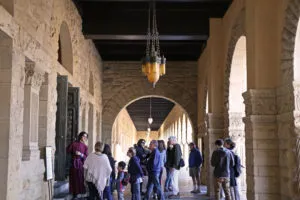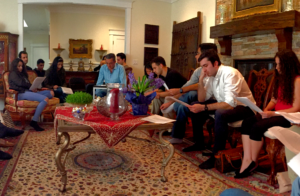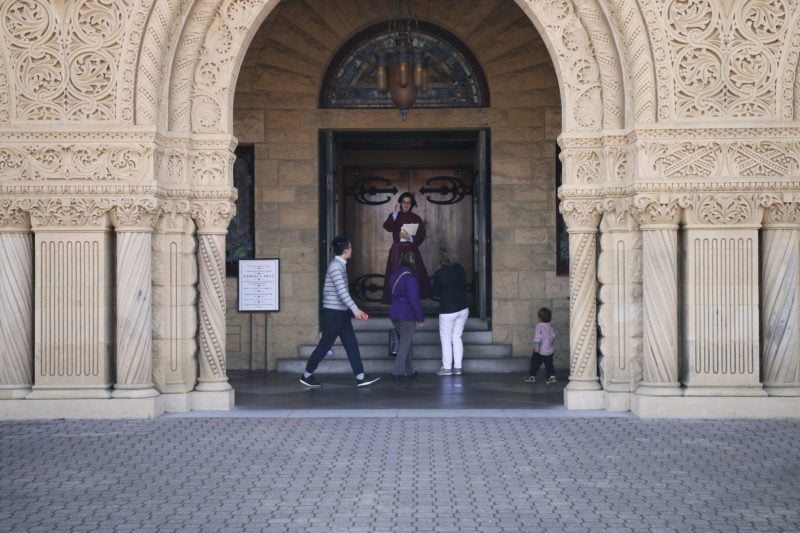The third floor of Old Union is the home of CIRCLE, a space devoted to interfaith dialogue and religious support.
The floor holds rows of offices, a student lounge and a large sanctuary. Inside the sanctuary, rows of chairs are set up next to banners with diverse religious imagery, including the Bahá’í nine-pointed star and the Buddhist wheel of dharma. Outside the sanctuary, a number of the offices are devoted to religious student organizations.
No obvious staircase leads to CIRCLE, an acronym for the Center for Inter-Religious Community, Learning and Experiences. Instead, students have to use the elevator or a side staircase to reach it, so for the non-religious Stanford student it is easy to forget the resource exists. Yet it is part of Old Union, one of the most central parts of campus.
At times, religious dialogue on campus can seem similarly invisible, even if it is fundamental to many Stanford students’ lives. The typical Stanford student, consumed by p-sets and papers, likely would not be described as a regular churchgoer — yet a closer look reveals tangible student interest in religion.

Approximately 40 religious organizations are active on campus, from the Jewish Student Association to the Hindu Students Association to the Quakers at Stanford. The Office for Religious Life regularly supports student organizations and religious programming. CIRCLE promotes interfaith dialogue and inclusivity.
Kent Blake ’16 M.A. ’17, a computer science coterm, is the president of Queerituality, a student organization that connects LGBTQ+ individuals to religious communities at Stanford. According to Blake, coming out as religious — like coming out as LGBTQ+ — can be difficult when students feel like they’re defying cultural norms of their university.
“I’m probably more reluctant to reveal that I grew up Mormon here than I would be at home,” Blake said.
Yet once he started talking to his peers about religion, Blake found more interest at Stanford than he expected.
“People are generally very understanding,” he said. “I thought that people would be hostile or confused, but the reaction I normally have when I come out as Mormon is more like ‘Oh, that’s interesting, tell me more.’”
Below, three religious Stanford students have shared their experiences acclimating to the campus culture and discovering religion’s place in their lives.
Sam Good ’22, Church of Latter Day Saints
As a freshman, Sam Good ’22 has recently begun his Stanford journey — but he’s already looking ahead to the next one. At the end of freshman year, he will leave Stanford to become a Mormon missionary in an as-yet-unknown location, striving to communicate his beliefs and serve his community.
Good is from Eden, a small town in Utah with a large population of Latter Day Saints. Growing up, Good at times felt at odds with his community because he questioned its principles of social conservatism.
“I felt like I was the odd one out,” he said. “I felt unaccepted when I would raise issues within a deeply conservative religious course. But coming here [to Stanford], that’s almost the norm.”
While many Mormons choose to pursue a mission trip immediately after high school, Good felt compelled to attend a year of college first. His desire to challenge traditional values and expose himself to new belief systems drew him to Stanford in particular, he said — it felt critical to test his faith outside of his religious community before deciding to spread his beliefs as a missionary.
“By coming here, I knew it would cement for me,” he explained. “Is this right for me? Do I believe this?”
Good says that since coming to college, his faith has, in fact, deepened. He studies Scripture daily and attends church services, Sunday classes and weekly dinners for the Latter-Day Saint Student Association (LDSSA), among other practices. He also serves as a fellowship committee member for the LDSSA, which involves reaching out to other Mormon students to foster friendships and a tight-knit community.
While Good’s faith remains constant, he has noticed differences in his religious experiences back home and at Stanford. Here, even within the Mormon community, he has noticed greater degrees of gender equality than in Eden.
Good observed that while women did receive religious leadership roles in his hometown and were described as equals, diffusion of responsibility and status still felt skewed towards men within the church.
“It’s incredible to see the amount of equality even within church meetings that didn’t necessarily exist growing up,” Good said.
One of his most transformative spiritual experiences still awaits, though, as Good’s mission trip draws closer. Good will find out his mission placement in April. Although the details of his mission vary widely by location, some elements remain constant, such as being matched with companions and adhering to a strict dress code that calls for a suit and tie.
He will also have strictly limited access to mainstream media. In many cases, missionaries are only allowed to email their families once a week and call on holidays, and they have little to no other access to the internet — a startling contrast to the tech-centered world of Stanford and Silicon Valley.
Despite these restrictions, Good says that mission trips have transformed in recent years, diverging from the stereotype of missionaries knocking on doors and giving speeches about their religion. Instead, missionaries are becoming increasingly service-focused.
“It’s no longer this goal of conversion by numbers and bringing people to church,” Good said. “It’s more of showing them, by example, that you know when you have the light of Christ in your life, you can be happier and live a happier life.”
For him, the trip means more than sharing his faith. Good looks forward to escaping the ambitious individualism fostered at college.
“Stanford — well, college in particular, but also Stanford — is a place where it’s really easy to think about yourself all the time,” Good said. “It’s all me, me, me, and there’s not a lot of time for reflection on others and really trying to serve. To have that break for two years — to just think about other people — is just going to make me a much better person, regardless of religion.”

Berkeley Churchill, Bahá’í Faith
Berkeley Churchill, a computer science Ph.D. student, identified as agnostic in high school. His parents were Bahá’í and he had learned about the faith, but during middle school and high school he found few reasons to believe it.
“I very much clung to this notion of wanting to have a mathematical proof written down if I wanted to believe something,” Churchill said.
Yet when he took an English class that involved the work of transcendentalist writers such as Ralph Waldo Emerson and Henry David Thoreau, elements of their works struck him as instinctively true. Churchill was drawn to the idea that there was a connection between nature and a greater power.
During that period, Churchill often walked home from school through a mile-long, wooded area.
“In this reflective state during these walks, I felt like what Thoreau and Emerson were saying seemed more and more true to me,” Churchill said. “This puts me in a fresh position to later look back at the Bahá’í writings and see things in there that actually reflect in my own experience.”
Now, as a Bahá’í, Churchill believes in the unity of different forms of religion and spirituality.
“This is not a mere statement that religions should just get along, but that actually, in their essence, religions are reflecting one reality,” Churchill said.
Each religion’s God — or Gods — is simply a conceptualization of a single, inherently unknowable God, according to Churchill’s descriptions of Bahá’í belief. These conceptualizations diverge because of the time, location and needs of the populations in which the religions arise, he explained.
“This perspective also allows us to understand different religions as looking at the same truth from different perspectives,” Churchill said.
Churchill’s relationship to his faith continues to develop as he practices. The Bahá’í faith observes a 19-day fast during March, and Churchill said that each year when he observes the fast, he discovers more ways that it is impactful. Fasting helps him realize how difficult it would be to live a less privileged life — to understand the reality that many people in the world do not receive three meals a day, he said.
“You can think about it as an act of love,” he added, reflecting on the custom at a more abstract level. “You’re making a sacrifice for something that’s greater than you.”
While Churchill says Bahá’í practices can be considered more individualistic than those of other religions, he values interacting with a community of Bahá’ís at Stanford. Approximately a dozen members of the Bahá’í Association at Stanford are currently active, and they gather for devotional meetings, community service planning and feasts. On a wider level, a global administrative structure links Bahá’í localities.
Although the Bahá’í faith is one of the world’s fastest-growing religions, Churchill noted that most Americans do not know what being Bahá’í means.
“In the U.S. in general, not that many people are familiar with the Bahá’í faith,” he said. “You could imagine some religious survey where people are asking questions and there are no options for Bahá’í.”
Michael Lu ’19, Mahayana Buddhism
Michael Lu ’19 found himself at a Buddhist monastery in Berkeley last winter, surrounded by curious Stanford peers.
Lu’s friends were not Buddhist, but they had often expressed interest in learning more about his beliefs and practices. In general, Lu has observed that many Stanford students are curious about religion. He believes that Buddhism, which promotes self-awareness and the study of the mind, may particularly appeal to students.
“I think that kind of instruction is really helpful for Stanford students,” Lu said. “That’s why I think that Buddhism might be practical.”
Lu emphasized that there is more to Buddhism than the classic image of meditation in isolation, citing 84,000 different practices that help followers “unfold [their] own wisdom,” as he put it.
Beyond meditation, Lu maintains his faith individually through practices such as reciting mantras and applying mindfulness to breathing. One of the most fundamental ways he rejuvenates his spirituality, though, is by visiting his hometown.
In fourth grade, Lu moved to the City of Ten Thousand Buddhas, a Buddhist community in Northern California that is one of a series of communities throughout California, Canada, Taiwan and other locales. Most of the 500-acre stretch of land in the Northern California hub is devoid of buildings, populated by vineyards and ranchland.
The central community includes a main Buddha hall, living quarters and gender-separated boarding schools, where Lu studied until college. The school curriculum integrates meditation studies and other elements that fortified Lu’s spirituality.
“The longer I am in my community, the more in touch with Buddhism I’ve been,” he said. “After coming outside, I lose a little of that connection, so I have to go back. It’s kind of like recharging, trying to get back into the spirituality.”
During his transition to Stanford, maintaining some elements of his religion proved particularly challenging.
For instance, Lu has chosen to adopt precepts, ethical codes that prohibit actions such as becoming intoxicated and eating meat.
“In some ways, I can’t interact with other people in certain ways that most people can,” Lu said. “I try to avoid certain things that would cause me or help me break my morals — for example, going to parties.”
At times, these restrictions lead to loneliness or feelings of estrangement. At home, too, Lu’s exposure to Stanford — and the diversity of beliefs, especially the liberal ones, held here — separate him from his peers.
Ultimately, though, he says he has gained a greater ability to navigate both worlds through his experiences. The serenity and stability he gains from his practice allow him to handle uncertainty, in any context, more effectively.
According to Lu, in the midst of hectic Stanford quarters, Buddhism allows him to “attain more equanimity — to not be moved so much by what is happening outside.”
In using his faith to navigate college, Lu exemplifies how many religious students combine Stanford and spirituality. To some of the Stanford student body, religious education might seem extraneous to intellectual life, pertaining to an unrelated understanding of the world. Yet for the three students who shared their stories in this piece, religion is inextricably linked to the college experience.
Lu achieves peace during finals week; Good reads scripture to try to become a more productive citizen; Churchill fasts to reflect on his position in the world. Simultaneously, each student encounters unfamiliar liberal perspectives and surprising conversations that spur constant reflection upon their motivations and beliefs.
Contact Claudia Heymach at cheymach ‘at’ stanford.edu.
